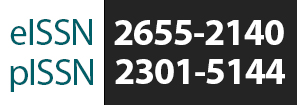Comparison of Democratic Design and Arts & Crafts Movement in the Face of Alteration Speed of the Industrial Revolution
Abstract
The industrial revolution that occurred in Europe until the 20th century is considered as a human achievement that changed the world. The pace of change brought by the Industrial Revolution starting from the first wave (1.0) to the fourth (4.0) led to various responses from various sectors, including from the art world. The Arts & Crafts Movement and the Democratic Design are examples of these forms of response. The relationship between those movements in art history is very afar. The two of them are separated for more over than two centuries. Both are movements that are based on a new thought and are changes in movements that affect changes in the future. This study was conducted to find the similarities of the two movements, to see the thoughts of the two and their impact on the development of design in the world up to this century. The study was conducted based on a literature study.
Downloads
References
Barter, Judith, A. (2009). Aposteles of Beauty : Arts and Crafts from Britain to Chicago. Chicago: The Art Institue of Chicago.
Bhaenanda, L. (2019). Mengenal Lebih Jauh Revolusi Industri 4.0. Diakses tanggal 26 Juli 2020 dari https://binus.ac.id/knowledge/2019/05/mengenal-lebih-jauh-revolusi-industri-4-0/
Blakesley, Rosalind, P. (2006). The Arts and Crafts Movement. London: Phaidon.
Danto, A. (1998). The Wake of Art, Criticism, Philosophy, and The End of Taste. Armsterdam: G-B Art International Imprint.
Faulkner, P. (1980). Againts the Age: An Introduction to William Morris. London: George Allen & Unwin.
Fukuyama, F. (1999). The Great Disruption: Human Nature and the Reconstitution of Social Order. London: Profile Books.
Gablik, S. (1988). Has Modernism Failed?. London: Thames and Hudson.
Kasali, R. (2017). Disruption : Tak Ada yang Tak Bisa Diubah Sebelum Dihadapi, Motivasi Saja Tidak Cukup. Jakarta: Gramedia Pustaka Utama.
Morris, W. (1884). Art and Socialism. Diakses 26 Juli 2020, dari https://www.marxists.org/archive/morris/works/1884/as/index.htm
Naylor, G. (1971). The Arts and Crafts Movement: A Study of its Source, Ideals and Influence on Design Theory. London: Studio Vista.
Ogata, Amy, F. (2001). Art Nouveau and the Social Vision of Modern Living : Belgian Artists in a European Context. Modern Architecture and Cultural Identity. Cambridge: Cambridge University Press.
Richards, K. (2017). IKEA’s Top Designer on The Gift of Failure and the Future of Democratic Design. Diakses tanggal 26 Juli 2020 dari https://www.adweek.com/creativity/ikeas-top-designer-on-the-gift-of-failure-and-the-future-of-democratic-design/
Susanto, Dwi. (2018). Pengantar Ilmu Sejarah. Jurusan Sejarah dan Kebudayaan Islam. Fakultas Adab dan Humaniora UIN Sunan Ampel Surabaya. http://digilib.uinsby.ac.id/20183/7/Pengantar%20Ilmu%20Sejarah.pdf
Shwab, K. (2016). The Fourth Industrial Revolution. New York: Crown Business.
Triggs, Oscar, L. (2009). The Arts and Crafts Movement. Art of Century Collection. New York: Parkstone International.
Van Der Meer, Annet. (2017). The Arts and Crafts Movement and Religion : A Crusade and Holy Warefare Againts The Age, An Analysis of The Artifacts By William Morris and Johan Thorn Prikker. Groningen: University of Groningen.
Weiss, P. (1975, May). Kandinsky and the ‘Jugendstil’ Arts and Crafts Movement. The Burlington Magazine117, no.866, Special Issue Devoted to Twentieth-Century Art.
Copyright (c) 2020 Panji Firman Rahadi

This work is licensed under a Creative Commons Attribution-NonCommercial 4.0 International License.
Authors who publish with Visualita agree to the following terms:
- Authors retain copyright and grant the journal right of first publication with the work simultaneously licensed under a Creative Commons Attribution-NonCommercial 4.0 International License.
- Authors are able to enter into separate, additional contractual arrangements for the non-exclusive public distribution and display of the journal's published version of the work (e.g., post it to an institutional repository or publish it in a book), with an acknowledgement of its initial publication in this journal.
- Authors wishing to include items (such as images or other media, or any creative works of others whether previously published or not) must contact the original copyright holder to obtain explicit permission to publish these items in Visualital. Writing permission should include: the title(s) of any copyrighted work, original place of publication if applicable, and an acknowledgement of having read Visualita copyright notice. Authors are responsible for obtaining this permission and keeping it in their own records for later verification.






